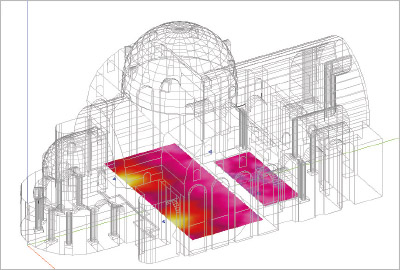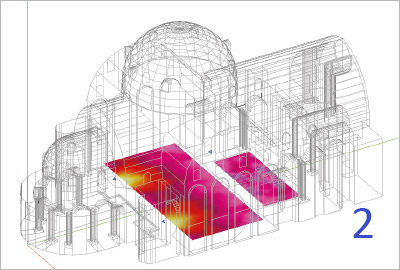The laying of the foundation stone of the Holy Cross Church by Bishop Hermann Dingelstad dates back to 1899, and as a result of the war-related destruction of the Cathedral of Münster, the Church of the Cross was elevated to the status of a procathedral in 1945. In 1946 Cardinal Clemens August Graf von Galen celebrated his first pontifical office. Only 5 days later the pontifical requiem for the suddenly deceased cardinal takes place in Heilig Kreuz. Today the Heilig Kreuz Gemeinde is a fusion of three parishes and more than 9000 Catholics. The Church of the Holy Cross now shines again in its old splendour after a comprehensive interior renovation. Uwe Sonntag, GF Seis Akustik, provided the concept for the renewal of the transmission technology and the song display system after a previous, intensive comparison. After in-depth testing of various systems, only the newly developed SDM10 audio-digital system from Seis Akustik was convincing. Furthermore, under the very difficult acoustic conditions that have arisen since the renovation, the superiority of the new XL sound shaper loudspeakers became more than clear. The special loudspeakers developed for use in acoustically challenging rooms always convinced with excellent word comprehension, even under the most diverse conditions. When selecting the new song indicator, the community clearly decided in favour of the ultra-flat, radio-controlled VISIO display system from Seis Akustik.
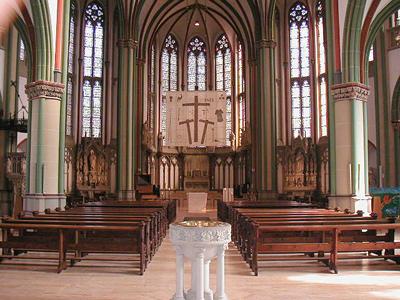
The gothic-style of Marien church in Gelnhausen, Hesse, first mentioned in a document in 1223, has undergone a series of conversions and reconstructions over the centuries. Only recently, a new sound system was installed by seis-akustik. Decisive for this decision was the outstanding sound quality and excellent speech intelligibility of our system, even under difficult acoustic conditions.
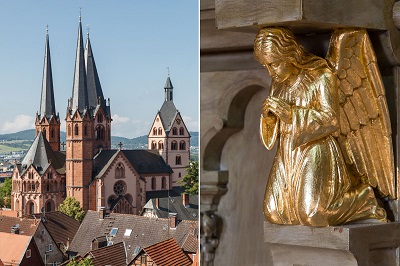
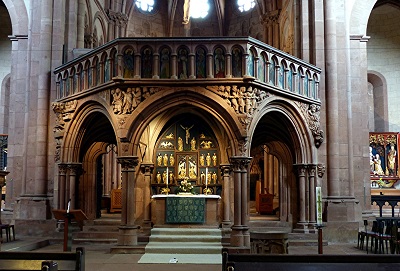
The pilgrimage cathedral was designed at the end of the 1960s by Gottfired Böhm, the only German winner of the Pritzker Prize. With over 6000 seats, the pilgrimage church is the second largest in North Rhine-Westphalia after the Cologne Cathedral. Franciscan monks of the affiliated monastery look after pilgrims from all over the world with church services and various offers for pilgrims. New microphone technology and a DSP control system complement the acoustic system. Very large response ranges and better transmission characteristics, digitally controlled and processed by a matrix mixer, guarantee advantages in speech intelligibility. The radio microphones used, in the new frequency range, already comply with the latest radio regulations and can be operated free of charge and without worries over the year 2015.
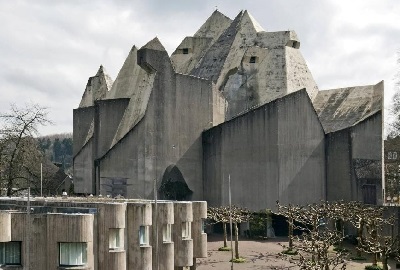
In the middle of the old town lies the cathedral of St. Bartholomew. The building history of the church began already in the 7th century. From 1356 on, as determined by the Golden Bull of Charles IV, the Roman kings were elected in the cathedral. Between 1562 and 1792, ten imperial coronations took place in the cathedral, but this tradition ended with the dissolution of the Holy Roman Empire of the German Nation. A fundamental reconstruction during the Romanesque period and brisk building activity during all periods of the Gothic changed the cathedral significantly until the big fire in 1867. With the repair of the war damages from 1948 onwards the cathedral got its present appearance. In its history, the sacred building has never been the cathedral church of a bishop but is under the care of the diocese of Limburg. The secular lord of the house is the city of Frankfurt. Every day guests from all over the world visit the church. Persistent complaints of the church visitors about the bad word comprehensibility in the service gave now the cause for the responsible persons to achieve an improvement of the speech intelligibility in the imperial cathedral as soon as possible. The Seis Akustik Team was commissioned to develop a new audio concept for the cathedral. On the one hand, the new audio system should ensure good speech intelligibility under the difficult acoustic conditions, but on the other hand, it should also meet the high demands of modern church use. Another important concern of the client was to achieve a simple "one-button operation" of the future transmission system. On behalf of the customer, a Seis Acoustics team, led by Ing. Jan Bril, first carried out an acoustic room analysis in the cathedral. Based on the results of the acoustic measurement, simulations were then carried out with "EASE" and subsequently the requirement profile for the technical implementation was created. This then served as a guideline for the selection of suitable loudspeaker arrays and their placement at the determined positions in the room. The subsequent test run of the new transmission technology in the cathedral quickly demonstrated the superiority of the new digital technology and convinced all those involved. The new system was completed in time for the Christmas service and passed the first test.
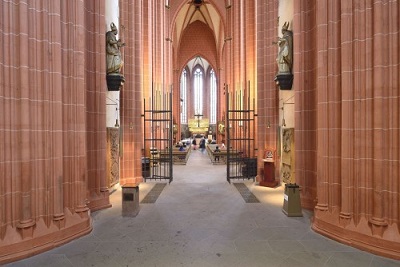
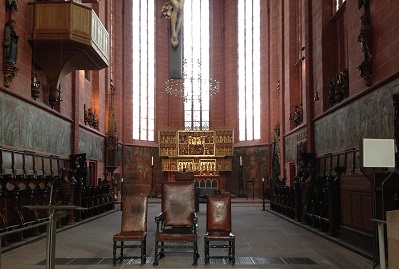
Embedded in the mountainous landscape of the Kellerwald, the former Cistercian abbey of Haina is located about 35 km north of the university town of Marburg. When the construction of the almost completely preserved monastery complex was begun around 1215, the monastery already had almost seventy years of history behind it. Construction of the monastery church began around 1216. Initially planned as a basilica in Romanesque style, the first eastern bay of the nave saw a change to the hall form. A first consecration of the church by Archbishop Siegfried of Mainz is attested for April 1, 1224. The uniformity and harmony of the room is impressive. The church was built at the crossroads of Romanticism and Gothic.
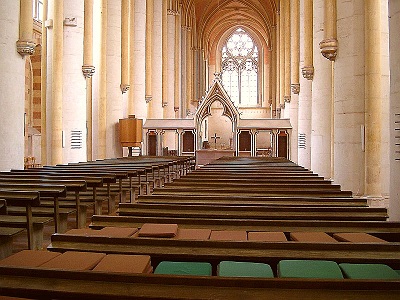
The Benedictine abbey is picturesquely situated at 125m above the Honigbach valley. Now, in the course of extensive renovation and modernisation measures, the transmission system has also been brought up to the latest state of the art. For the renewal of the microphone technology, it was important to those responsible to engage a company that could not only provide a technically future-proof solution but also an optically appealing integration. After a thorough trial run, the decision was made in favour of the most modern audio-digital technology from Seis Akustik. In addition to 24 newly developed special loudspeakers, high-quality designer condenser microphones from the MK5 series were used. Father Sebastian was also highly satisfied with the new technology in the abbey church: "At last we have a microphone system that masters our difficult acoustic conditions and fully meets our requirements!
In 2013, the old Willehadi Church burned down completely except for two pieces of the outer wall. Already in 2017 the first service was celebrated in the rebuilt church with technology from Seis Akustik. The new construction of the church gave the unique opportunity to upgrade the acoustic system and the media technology equipment to a modern, contemporary standard. Based on our concept for a demand-oriented audio and media technology with high ease of use, a media control system specially programmed by Seis Akustik was installed. All settings can easily be made on a touch display, e.g. wirelessly via WLAN. No matter whether you want to transmit speech, play music or project entire pictures or films, every medium will be part of everyday church life in the future. The entire signal structure was mapped in digital technology. This includes Seis acoustic digital audio technology as well as two image projections in HDBaseT standard with beamers that can be extended from the ceiling.
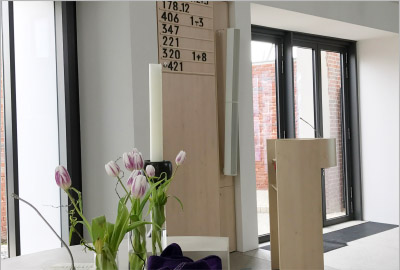
A very special challenge for our specialists was the acoustic inspection of the St. Bernhard Church in Frankfurt's Nordend district. Persistent complaints from church visitors about poor word comprehensibility gave rise to a detailed acoustic analysis of the very difficult acoustic conditions in the church interior. The aim of the measure was to achieve good speech intelligibility for all churchgoers. The measurements were carried out with the software "EASERA and Systune" and certified "Class 1" audio measurement technology from Brüel & Kjaer. The basis for all calculations was provided by the simulation software "EASE" (Enhanced Acoustic Simulator for Engineers) by Prof. Dr. W. Ahnert and the "Aura" module by Prof. Dr. W. Vorländer.
